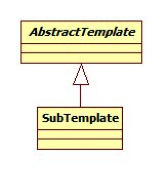应用场景很多,尤其是在框架设计中,提供了一个方便的开发程序的模板,你只要实现模板中的一些接口或者方法就能完成一个复杂的任务。
结构类图

AbstractTemplate:定义一个完整的框架,方法的调用顺序已经确定,但会定义一些抽象的方法留给子类去实现。
SubTemplate:实现抽象模板中定义的抽象方法,从而形成一个完整的流程逻辑。
1
2
3
4
5
6
7
8
9
10
11
12
13
14
15
16
17
18
19
20
21
22
23
24
25
26
27
28
29
30
31
32
33
| public TradeFlowActionResult execute(TradeFlowActionParam param, Map context) throws ServiceException {
try {
this.validateBusinessLogic(param, context);
} catch (ServiceException ex) {
sendGoodsLog.info("SendGoodsAction->validateBusinessLogic got exception. param is " + param, ex);
throw ex;
} catch (RuntimeException ex) {
sendGoodsLog.info("SendGoodsAction->validateBusinessLogic got runtime exception. param is " + param, ex);
throw ex;
}
try {
this.sendGoods(param, context);
} catch (ServiceException ex) {
sendGoodsLog.info("SendGoodsAction->sendGoods got exception. param is " + param, ex);
throw ex;
} catch (RuntimeException ex) {
sendGoodsLog.info("SendGoodsAction->sendGoods got runtime exception. param is " + param, ex);
throw ex;
}
try {
this.addition(param, context);
} catch (ServiceException ex) {
sendGoodsLog.info("SendGoodsAction->addition got exception. param is " + param, ex);
throw ex;
} catch (RuntimeException ex) {
sendGoodsLog.info("SendGoodsAction->addition got runtime exception. param is " + param, ex);
throw ex;
}
return null;
}
|
上面提到的三个抽象方法(业务逻辑校验、卖家发货业务逻辑、补充业务)都是在子类中实现的。
使用模板方法模式既控制了主流程结构,又不失灵活性,可以让使用者在其基础上定制开发。





